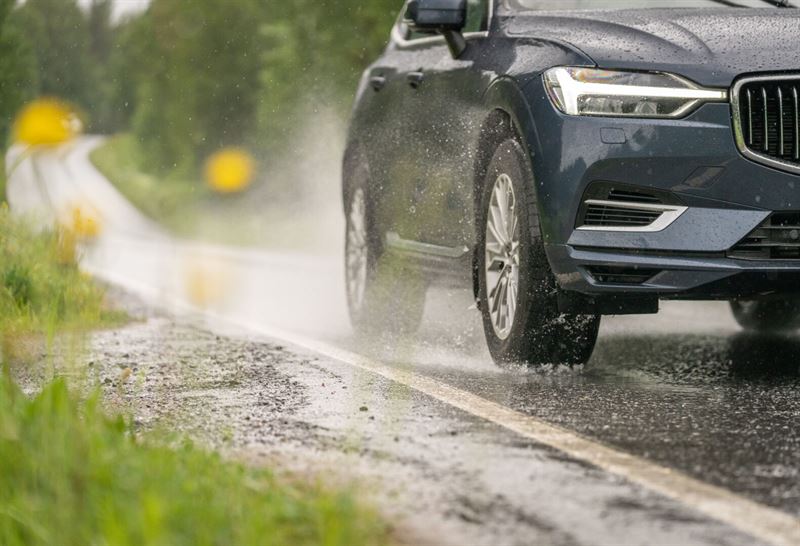Aquaplaning: a few milimeters of tread depth can make huge difference in your driving safety

At the end of the summer season, drivers can encounter sudden torrential storms that can instantly turn some sections of road into high-risk zones with the lurking danger of aquaplaning. Tire manufacturer Nokian Tyres explains what to look out for during the rainy season and why just a few millimeters of tread can make all the difference.
Aquaplaning is a real threat in rainy weather. As soon as the tread is unable to drain all the water away from the point of contact between the tire and the road, a water cushion forms under the tire. This causes the tires to lose their grip and the driver loses control of their vehicle.
"In this situation, the driver can become a helpless passenger with no control over his/her vehicle in an instant. However, the most important thing is to keep calm and not brake suddenly. It’s best to take your foot off the accelerator, let the car slowly reduce speed and keep a close eye on the direction of travel. As soon as you feel the tires regain contact with the road, you can gradually start to accelerate again", says Martin Dražík, Product Manager for Central Europe at Nokian Tyres.
There is a real risk of aquaplaning even with good tires, but it’s almost certain with worn ones. That’s why it’s important to be aware of the condition and quality of the tires on your car. As a rule of thumb, the smaller the tread depth, the more likely the tires will lose their grip on the wet road. Therefore, driving on worn tires is a major risk, especially in the rain, when the braking distance is significantly longer. You thus become a danger not just to yourself, but to everyone around you.
Drivers who have put off purchasing new tires should pay even more attention to the proper maintenance of their current ones, so that their safety features last as long as possible. The risk of aquaplaning can be reduced by using tires with a tread of at least 4 mm. As soon as tread depth falls below this figure, your protection from this dangerous phenomenon deteriorates significantly. The correct tire pressure is also important.
"Our tires have several innovations that simplify safe driving and tire condition monitoring. One of these is the patented Driving Safety Indicator that allows the driver to immediately see how many millimeters of tread are remaining of each individual tire with their naked eye", adds Dražík.
It’s important to anticipate dangerous situations
Heavy rain and poor tire condition are a bad combination. Similarly, driving too fast in bad weather makes your vehicle more prone to aquaplaning, even if you have good tires. In heavy rain, speed may need to be reduced by as much as 15-20 km/h so that the tread can pump away all the water between the tire and the road.
“I don't understand why so many people drive in ruts on the road even when it's raining. This is exactly where the risk of aquaplaning is highest. Driving in ruts also wears down tires faster because the asphalt is much rougher there. That's another reason to drive outside of ruts," remarks Martin Dražík from Nokian Tyres.
Tests carried out by Finnish magazine Mootori (03/2020) showed that worn tires started aquaplaning at a speed as much as 15 km/h earlier than new tires. For the best tire tested, the new tire started aquaplaning at 90,4 km/h while a tire worn down to just 3,5 mm already started aquaplaning at around 75 km/h. In addition to tread depth, tire pressure should also be checked. Low pressure increases the risk of aquaplaning. Checking your tire pressure and adjusting it to the correct level, if necessary, is a basic safety measure that you can take at your nearest petrol station and it doesn’t cost a thing.
Tips for dealing with the risk of aquaplaning
- Check the condition of your tires before every trip, maintain a sufficient tire pressure and make sure that tread depth is at least 4 mm to ensure driving safety.
- Check the weather report before driving and anticipate dangerous situations, these include heavy downpours or thunderstorms.
- Do not drive in ruts on the road in the rain.
- Reduce your driving speed by at least 20 km per hour during heavy rain and downpours.
- Keep sufficient distance to vehicles in front of you.
- If aquaplaning occurs, stay calm, take your foot off the accelerator and let the car slow down until you feel contact between the tires and the road again and maintain your direction of travel.
Photographs:
Download pictures
More on the topic:
Further information:
Zuzana Seidl, PR Manager Nokian Tyres CE, 00420 603 578 866,
zuzana.seidl@nokiantyres.com
Twitter I YouTube I Facebook I LinkedIn I Instagram
Nokian Tyres develops and manufactures premium tires for people who value safety, sustainability and predictability. Our purpose is to empower the world to drive and work smarter. Inspired by our Scandinavian heritage, we craft innovative products for passenger cars, trucks and heavy machinery that give you peace of mind in all driving and working conditions. Our Vianor chain provides tire and car services. In 2021, the company’s net sales were EUR 1.7 billion and it employed some 4,900 people. Nokian Tyres is listed on Nasdaq Helsinki. Further information: www.nokiantyres.com
Tags:




